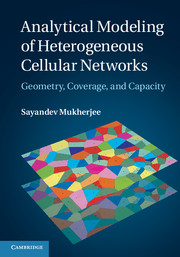Book contents
- Frontmatter
- Contents
- Preface
- Acknowledgemants
- List of notation
- List of acronyms and abbreviations
- 1 Introduction
- 2 Structure of the SINR calculation problem
- 3 Poisson point processes
- 4 SINR analysis for a single tier with fixed power
- 5 SINR analysis for multiple tiers with fixed powers
- 6 SINR analysis with power control
- 7 Spectral and energy efficiency analysis
- 8 Closing thoughts: future heterogeneous networks
- Appendix A Some common probability distributions
- Appendix B HCNs in LTE
- References
- Author index
- Subject index
Preface
Published online by Cambridge University Press: 18 December 2013
- Frontmatter
- Contents
- Preface
- Acknowledgemants
- List of notation
- List of acronyms and abbreviations
- 1 Introduction
- 2 Structure of the SINR calculation problem
- 3 Poisson point processes
- 4 SINR analysis for a single tier with fixed power
- 5 SINR analysis for multiple tiers with fixed powers
- 6 SINR analysis with power control
- 7 Spectral and energy efficiency analysis
- 8 Closing thoughts: future heterogeneous networks
- Appendix A Some common probability distributions
- Appendix B HCNs in LTE
- References
- Author index
- Subject index
Summary
The ever-rising demand for wireless data means that conventional cellular architectures based on large “macro” cells will soon be unable to support the anticipated density of high-data-rate users. Thus future wireless network standards envisaged by standards bodies like the Third Generation Partnership Project (3GPP), such as LTE Release 12 and later, rely on the following three ways of increasing system capacity: (a) additional spectrum; (b) enhanced spectral efficiency; and (c) offloading from the cellular network onto, say, WiFi.
So-called “small” cells are an attractive method of increasing spectral efficiency by means of spatial reuse of resources. Small cells can also exploit the fact that additional spectrum in the coming years will be freed up at higher frequencies, where path loss is higher than in the frequencies currently employed in macrocellular networks. A dense deployment of small cells can achieve the desired objective of high system capacity. However, such deployments are unlikely to be found outside of high-traffic areas such as major population centers. Thus, basic connectivity and mobility support will continue to be handled by macrocells. In other words, the wireless cellular network of the future is likely to be a heterogeneous cellular network (HCN), with more than one class of base station (BS).
How HCNs are studied and designed today
One of the most important metrics of network performance and user experience is the signal to interference plus noise ratio, or SINR, defined as the ratio of received signal power to the total received power from all sources other than the desired transmitter (i.e. from all interferers), plus the thermal noise power at the receiver (which is always present, even in the absence of any interferer).
- Type
- Chapter
- Information
- Analytical Modeling of Heterogeneous Cellular NetworksGeometry, Coverage, and Capacity, pp. ix - xiiPublisher: Cambridge University PressPrint publication year: 2014



